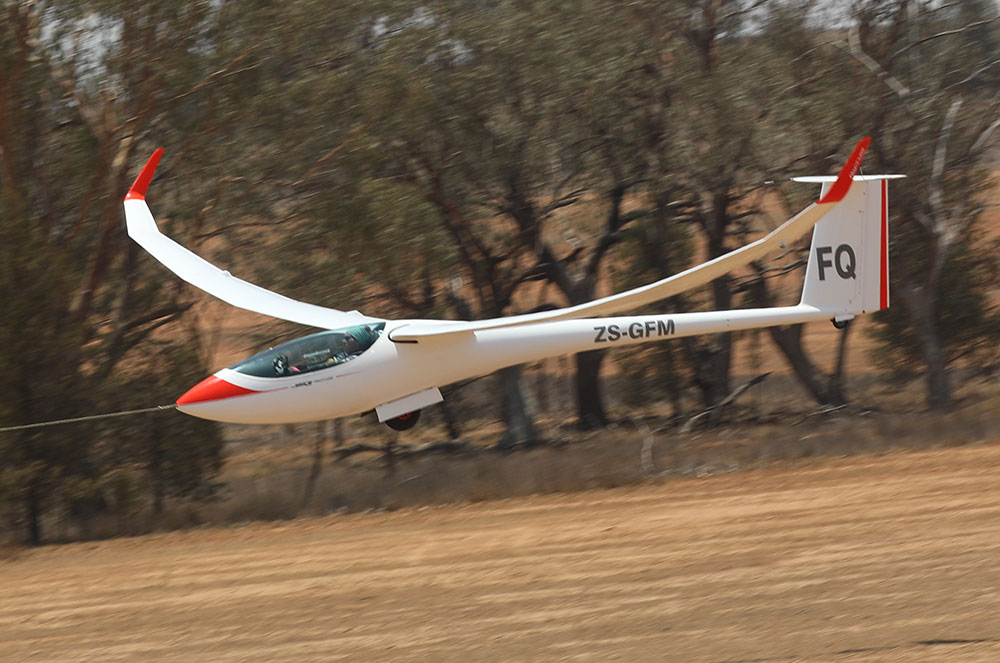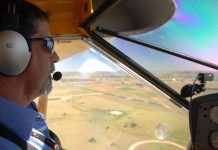
The author warns about gliders spearing off to one side at launch and, on a couple of occasions, being written off.
By James Cooper
I once stopped within a metre of a tree when launching at a local club where they used a Pawnee 260 as tug. However, our club has launched with the less powerful Pawnee 180 for many years and we never had issues with gliders spearing off to one side that I am aware of.
I have many years of experience flying an SZD 55 with a tendency to drop a wing on launch, potentially giving grief to the pilot.
Asymmetry appears to be the problem in all cases of launches when gliders spear off to one side of the direction of launch. There are two types of asymmetry in question—aerodynamic and mass. I will deal with aerodynamic asymmetry first as I have more personal experience with it.
As I mentioned, I used to fly an SZD 55. Looking at the 55 reveals a high undercarriage, allowing good ground clearance when out landing in other than perfect paddocks. This gives the wings a high angle of attack when on the ground but creates issues on launch, particularly when there is a crosswind, as the prop draft at the time of launch would go over one wing—the left wing.
With the high angle of attack, the wing receiving the prop draft would lift, pushing the right wing, in this case, into the ground and making for an unpleasant launch. If the glider had water in the wings but was not full, the water would now rush to the downwind wing, making the launch even more unpleasant.
Only after some time of full rudder and aileron would things get themselves under control.
Prevention
So how to resolve this issue? The first thing that I learnt was to keep the air brakes open at launch. The reason for this was that it reduced the amount of lift over both the inboard and outboard part of the wings, thus leaving the outboard part, where the ailerons were, to control the horizontal stability of the glider. During pre-take-off checks, when I got to ‘air brakes’, I would close them until I was hooked on and only at that point open the brakes. Most members of the club were aware of my launching method.
Once the glider reached about 30 knots, full aerodynamic control was available and the air brakes were closed and locked. The reason for the initial close and lock was to ensure the air brakes worked and were closed and locked if, for some reason, I forgot to open them during the launch procedure.
A secondary requirement to prevent a wing drop was to fully ballast the glider, as per SZD’s instructions. It did make me slightly overweight but my feeling was that being slightly overweight was better than having water sloshing in the wings, which would very quickly make one side of the glider heavier than the other. Once I was flying, I would drop as much water as was necessary to bring me to the weight I needed for the flight. One final issue that resolved—the wing lift with the prop draft was the fact that we had a Pawnee 180 as tug. As it was a little less powerful than the more common 260, it created a milder blast of air over the wing that would otherwise have caused the downwind wing to lift.
Launching out of paddocks
The high angle of attack of the wings on the 55 did give an advantage when launching out of paddocks. If the paddock launch had a slight crosswind, I would be sure the downwind wing was the one on the ground. The prop draft would have a tendency to lift the wing in the early part of the take-off roll.
If I was launching straight into wind, I would set the glider pointing in the same direction as the tug but with the ground wing straight behind the tug, again so that the prop draft would assist in lifting it during the start of the take-off. However, the best method was to find some sticks from the edge of the paddock and put one under each wing, so that there was no wing drag.
Mass asymmetry
Having looked at aerodynamic asymmetry, let’s now look at the second type, mass asymmetry. Certainly, one of the glider write-offs that I am aware of was caused by this type. The glider for some reason had more water in one wing than the other which occurs, as mentioned earlier, if the glider is not full and the water sloshes to one side of the glider due to a wing drop.
Now imagine pulling your glider, by hand, with a tow rope attached to the nose. As you pull, the glider will dutifully follow you because the main wheel is pointing in the same direction as you are pulling. In addition, the tail wheel that should be equally aligned is maintaining directional stability.
Now consider what would happen if one wing only—say, the left—was full of water and therefore heavier, and supported by the wing walker. As you pull the glider by hand, it will still obediently follow behind you. The problem occurs when you try to accelerate the glider rapidly. The centre of gravity is no longer in the centre of the glider, but somewhere in the middle of the left wing.
During rapid acceleration behind the tug, the glider will naturally rotate around the centre of gravity, rapidly turning to the left. What is staggering is how rapidly the glider rotates. It’s no wonder the GFA has a ruling stating that there should be no objects in a zone 45° either side of the take-off direction.
Myth and reality
Let’s look at the myth and reality of the first few seconds of take-off. The myth says that if the tug accelerates quickly, aileron control will be reached sooner. The fact is that things go pear-shaped well before any aileron or rudder control is achieved. In contrast, a slow initial acceleration by the tug gives neither a strong prop draft under one wing nor a high acceleration where the glider wants to rotate around an offset centre of gravity.
If asymmetry exists, the tail wheel’s desire to keep the glider moving straight will overrule any desire to rotate. So, if clubs want to resolve the issue of gliders spearing off to the side of the launch direction—do not use full power on the tug until the glider is rolling at a speed that will allow rudder and aileron control greater than any asymmetry that may exist.
Reprinted courtesy Gliding Australia





Comments are closed.